bio 208 lecture exam 4
0.0(0)
0.0(0)
Card Sorting
1/238
There's no tags or description
Looks like no tags are added yet.
Study Analytics
Name | Mastery | Learn | Test | Matching | Spaced |
|---|
No study sessions yet.
239 Terms
1
New cards
Describe the process of light and dark adaptation and include the role of the rods and cones.
Rods respond to low-intensity light that provides peripheral vision, while cones respond to bright-light that provide color vision. During light adaption, rods are inactive, and the cones respond, causing high visual acuity. In dark adaption, cones are inactive, and rods respond when sufficient rhodopsin accumulates.
2
New cards
What two things does the ciliary body do?
It is found behind the iris and includes a ring-shaped muscle. This muscle changes the shape of the lens when the eye focuses. It makes clear fluid that fills the space between the cornea and the iris.
3
New cards
Explain the three phases of an action potential (include hyperpolarization).
Depolarization – is caused by Na+ flowing into the cell; decrease in polarity, inside becomes more like outside (inside more positive)
Repolarization – is caused by K+ flowing out of the cell; - increase in polarity, inside becomes less like outside (inside more negative)
Hyperpolarization – is caused by K+ continuing to leave the cell; super polar, inside even more negative.
Repolarization – is caused by K+ flowing out of the cell; - increase in polarity, inside becomes less like outside (inside more negative)
Hyperpolarization – is caused by K+ continuing to leave the cell; super polar, inside even more negative.
4
New cards
Explain how neuron diameter and degree of myelination affect conduction speed of an axon.
Larger neuron diameters have a higher conduction velocity because they can send signals faster. Myelination is a saltatory conduction and increases the speed with which action potential travels in axons. Fatter axons carry action potential faster. Myelination and large axon diameters increase spike propagation speed.
5
New cards
Explain the events at a synapse.
The synapse is the gap between neurons. At the synapse, one neuron sends a message to a target neuron. There are two types of synapses: chemical and electrical. Chemical synapses use neurotransmitters. Electrical synapses use gap junctions to transmit ions directly. Neurotransmitters cross the synapse by binding to the postsynaptic neuron. This causes two types of graded potential.
6
New cards
Explain the structural and functional difference between gray and white matter of the cerebrum. Include the functional areas of the cerebral cortex
Gray matter – myelinated; contains the cell bodies, dendrites, and the axon terminals. In the cerebrum, gray matter created the cerebral cortex.
White matter – unmyelinated; made up of axons that connect the gray matter together. In the cerebrum, white matter connects different hemispheres of the brain.
White matter – unmyelinated; made up of axons that connect the gray matter together. In the cerebrum, white matter connects different hemispheres of the brain.
7
New cards
Explain the functions of the hypothalamus.
Connected to the pituitary gland via the infundibulum. It maintains homeostasis.
8
New cards
Explain the structural and functional differences between the gray and white matter of the spinal cord
Gray matter – creates a hornlike structure throughout the inside of the spinal cord. Extends to the spinal cord to make signaling more effective.
White matter – Makes up the surrounding sections of the spinal cord. Conducts, processes, and send nerve signals up and down the spinal cord.
White matter – Makes up the surrounding sections of the spinal cord. Conducts, processes, and send nerve signals up and down the spinal cord.
9
New cards
Explain the classification of receptors based on stimulus type
Mechanoreceptors- touch, pressure
Thermoreceptors- change in temperature
Photoreceptors- light energy
Chemoreceptors- chemicals
Nociceptors- pain
Thermoreceptors- change in temperature
Photoreceptors- light energy
Chemoreceptors- chemicals
Nociceptors- pain
10
New cards
Explain the components of a reflex arc and __provide examples__.
The components of a reflex arc are a receptor that receives stimulus, a sensory neuron, a control center, an interneuron, a motor neuron, and a muscle. The reflex action is carried out by the sensory neuron traveling to the muscle via the interneuron. This happens when we touch something hot, when are knee jerks when someone hits it, or when lights hit the pupil of the eye.
11
New cards
Briefly explain the structural and functional differences between the sympathetic and parasympathetic division of the ANS
Sympathetic division – “fight or flight response,” prepares the body for strenuous physical activity.
Parasympathetic division – “rest and digest,” actions that do not require a rapid response.
Parasympathetic division – “rest and digest,” actions that do not require a rapid response.
12
New cards
Explain the different types of ANS receptors for sympathetic and parasympathetic.
The sympathetic receptors are alpha and beta receptors. Epinephrine and norepinephrine stimulate these receptors. The parasympathetic contains the nicotinic and muscarinic receptors that cause salivation and lacrimation.
13
New cards
description of Spatial summation (location changes, but time constant)
\
\
○ Post synaptic potentials are transmitted at different locations but simultaneously
14
New cards
15
New cards
16
New cards
A combination of IPSPs and EPSPs need to..
● __summate__ to reach threshold in order for an AP to happen
17
New cards
IPSP + epsp =
summation
18
New cards
Two parts of CNS
● Brain + spinal cord
19
New cards
what do Sulci-shallow grooves do
\
\
● Separates the precentral gyrus and postcentral gyrus
20
New cards
■ Longitudinal fissure
● Separates two hemispheres
21
New cards
Transverse fissure
● Separates cerebrum from cerebellum
22
New cards
what are the lobes?
○ Frontal
○ Temporal
○ Parietal
○ Occipital
○ Insular - Under the temporal lobe
○ Temporal
○ Parietal
○ Occipital
○ Insular - Under the temporal lobe
23
New cards
what is a Chemical synapse
■ neurotransmitters
24
New cards
description of EPSP: excitatory __post__synaptic potential
\
\
An EPSP, or excitatory postsynaptic potential, is a local depolarization of the postsynaptic membrane that occurs in response to the binding of a neurotransmitter to its receptor on the postsynaptic cell. This depolarization is caused by an influx of positively charged ions, primarily sodium (Na+), into the cell.
25
New cards
simple description of EPSP: excitatory __post__synaptic potential
\
\
○ Local depolarization
○ Inflow Na+
○ Inflow Na+
26
New cards
description of IPSP: inhibitory postsynaptic potential
\
\
○ Local hyperpolarization
○ eflow K+
○ eflow K+
27
New cards
The effects of the NTs are determined by…
■ the receptors they bind to
28
New cards
○ How do these (graded) post synaptic potentials (PSP) create an AP?
through summation
29
New cards
Summation-
■ adding up all the graded potentials ( IPSP/EPSP) together that affect one cell
30
New cards
description of Temporal summation (time is the factor that changes, location is same)
\
\
○ Post synaptic potentials are transmitted in a rapid fire, one right after the other,manner in the same location
31
New cards
what is a Electrical synapse
\- uses gap junctions to transmit ions directly
32
New cards
○ How do we cross the synapse?
■ Neurotransmitters
■ When it binds to the postsynaptic neuron, it can causes 2 types of graded potentials
■ When it binds to the postsynaptic neuron, it can causes 2 types of graded potentials
33
New cards
The function of the nervous system
communication
34
New cards
What are the three steps of communication in the nervous system?
■ Gather sensory input from receptors.
■ Integration - Interpreting what the sensory info means and determining a proper response
■ Motor Output
■ Integration - Interpreting what the sensory info means and determining a proper response
■ Motor Output
35
New cards
what does the CNS (central nervous system) include?
Brain, spinal cord
36
New cards
What does the PNS (peripheral nervous system) include?
everything else besides brain and spinal cord
37
New cards
difference between afferent and efferent
afferent = sensory
efferent = motor
efferent = motor
38
New cards
Is the somatic nervous system voluntary or involuntary?
voluntary
39
New cards
is the autonomic nervous system voluntary or involuntary
involuntary
40
New cards
two division types of ANS and definitions
● Sympathetic Division
○ “Fight or flight response”
● Parasympathetic division
○ “Rest and digest”
○ “Fight or flight response”
● Parasympathetic division
○ “Rest and digest”
41
New cards
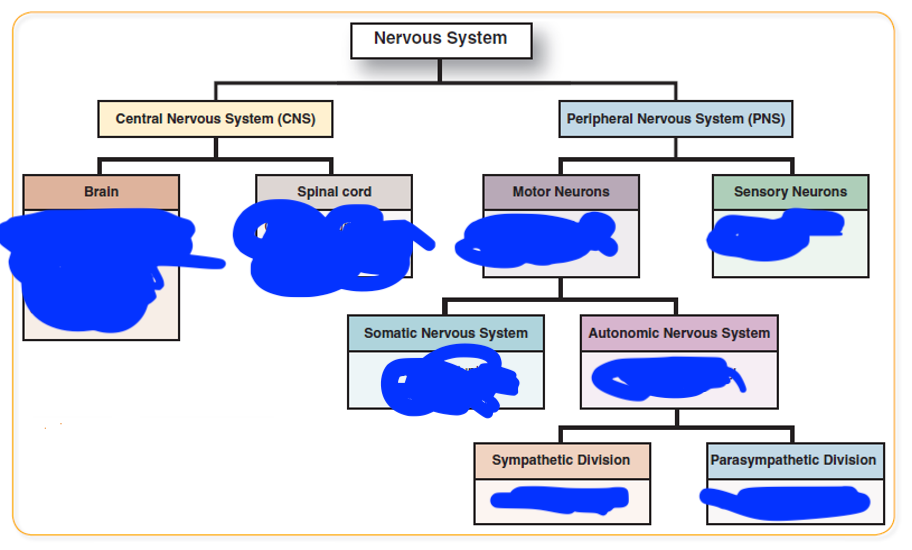
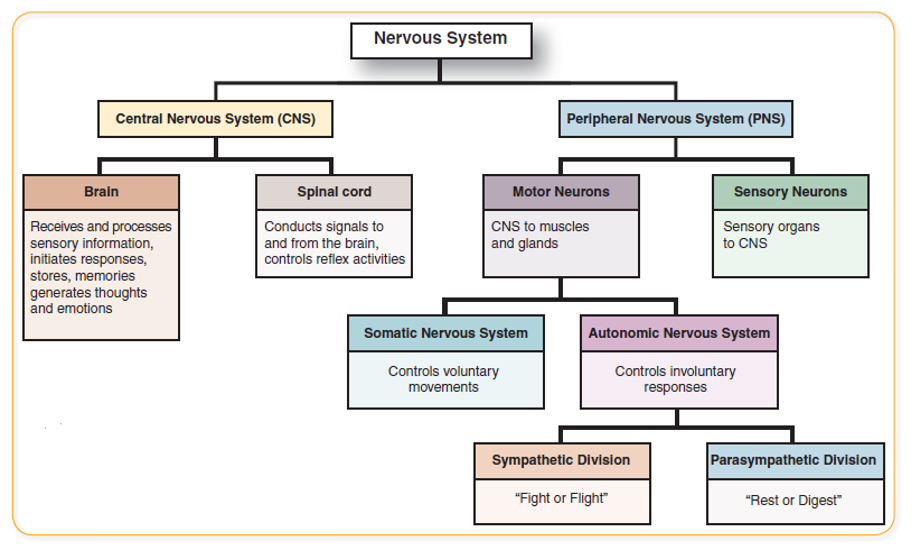
42
New cards
what do neurons do?
■ Conduct nervous impulses (action potentials)
43
New cards
neurons are amitotic. what does amitotic mean?
does not divide
44
New cards
is the metabolic rate of neurons high or low
high
45
New cards
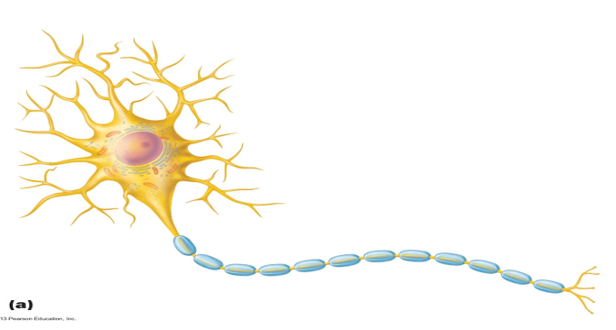
what are the main structural parts of a neuron?
Dendrites
Soma
Axon
Myelin sheath
Soma
Axon
Myelin sheath
46
New cards
what do the dendrites do
receives signal
47
New cards
what is the soma of a neuron
cell body
48
New cards
what does the axon of a neuron do
sends the signal away
49
New cards
what are the two parts of an axon and description of each
○ Axon Terminal- end of the axon
○ Axon Hillock- beginning of the axon
○ Axon Hillock- beginning of the axon
50
New cards
myelin sheath definition
● covering of the axon, purpose is to insulate the axon. Helps the speed of conduction.
51
New cards
what are the gaps in the myelin sheath called?
Nodes of Ranvier
52
New cards
what cells are found in the PNS
schwann cells
53
New cards
what cells are in the CNS
oligodendrocytes
54
New cards
what do Neuroglia/glial cells do
\
\
**● Protect and support neurons**
55
New cards
what are the four different types of cells in the CNS
astrocytes
microglial cells
ependymal cells
oligodendrocytes
microglial cells
ependymal cells
oligodendrocytes
56
New cards
what do astrocytes do?
○ Structural support of neuron
○ Recycle neurotransmitters
○ Recycle neurotransmitters
57
New cards
what do microglial cells do
Immune cells, monitor health of neuron
58
New cards
what do ependymal cells do
○ Help circulate CSF (cerebrospinal fluid)
59
New cards
what do Oligodendrocytes do
○ Forms the myelin sheath in the CNS
60
New cards
what are the two PNS cells
satellite cells
schwann cells
schwann cells
61
New cards
what do satellite cells do
○ Surround neurons and provide support
62
New cards
what do schwann cells do
○ Form myelin sheath in the PNS
63
New cards
what does the sensory/afferent do
\
\
■ Conduct impulses from receptors toward CNS
64
New cards
what does the motor/efferent do
\
\
■ Conduct impulses from CNS toward effectors
65
New cards
what does the interneurons/association do
\
\
■ Conduct impulses between motor and sensory neurons for the purpose of integration
66
New cards
what are the four parts of a membrane potential/ sodium-potassium pump
Channel
Pump
Leakage channels
Gated ion channels
Pump
Leakage channels
Gated ion channels
67
New cards
what is a channel?
→ passive transport, things down concentration gradient
68
New cards
what is a pump?
→ active transport, things against concentration gradient
69
New cards
what is a Leakage channels-
always open and allow ions to flow down their concentration gradient
70
New cards
what is a Gated ion channels
■ - allow ions to flow down concentration gradients when open
71
New cards
what are the three types of gated ion channels?
● chemically/ligand gated
● Voltage gated
● Mechanically gated channel
● Voltage gated
● Mechanically gated channel
72
New cards
what is chemically/ligand gated?
\
\
○ Open in response to binding of a chemical (NT)
73
New cards
what is Voltage gated?
\
\
○ Open to a response in membrane potential
○ Change in voltage opens
○ Change in voltage opens
74
New cards
what is Mechanically gated channel?
\
\
○ Open in response to mechanical stimuli
75
New cards
what are the charges of inside and outside the membrane potential?
● Inside: negative (-70mV)
● Outside: positive
● Outside: positive
76
New cards
what is the membrane potential maintained by?
○ 3 Na+ out, 2 K+ in (1 ATP used)
■ High extracellular levels of Na
■ High intracellular levels of K
● Negatively charged proteins
● Membrane is 25X more permeable to K+
■ High extracellular levels of Na
■ High intracellular levels of K
● Negatively charged proteins
● Membrane is 25X more permeable to K+
77
New cards
description of Membrane is 25X more permeable to K+
\
\
○ But since membrane is extremely permeable to K, it can leave the cells more readily than sodium can flow back in through leak channels
78
New cards
Electrical currents are due to the movement of ions across…
cell membranes
79
New cards
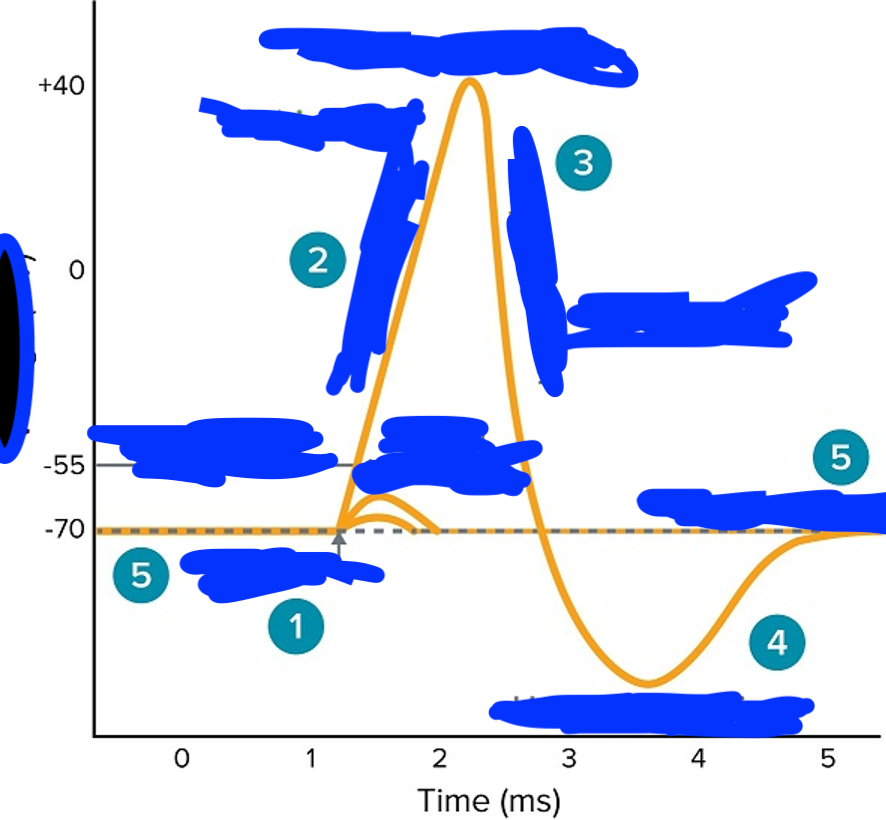
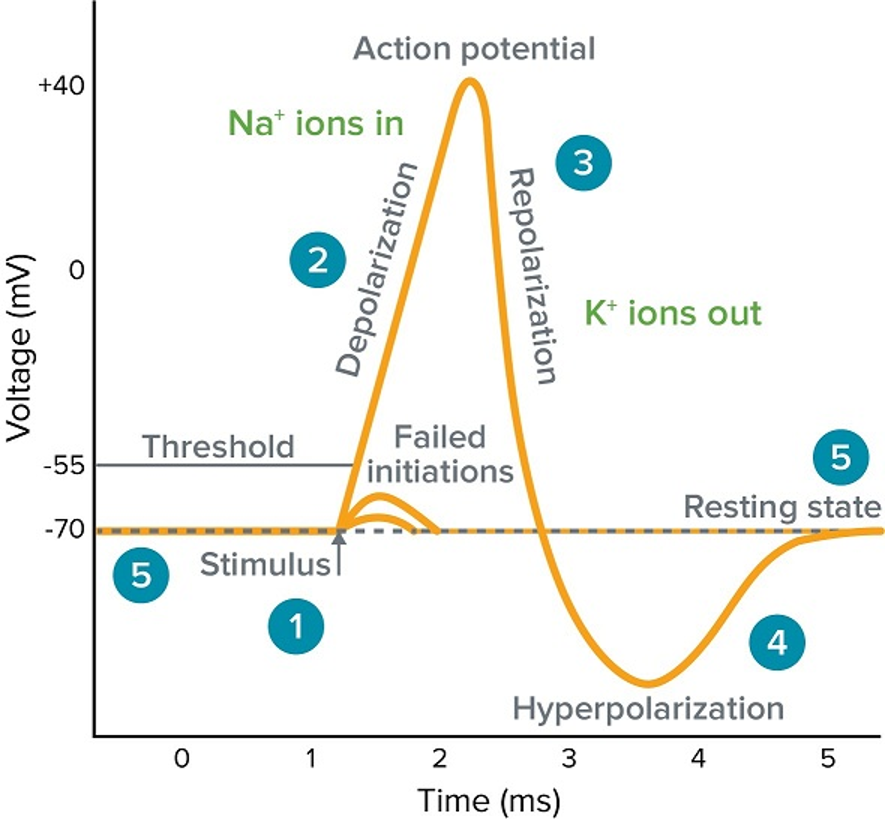
80
New cards
Depolarization =
○ decrease in polarity, inside becomes more like outside (inside more positive)
81
New cards
Repolarization-
○ - increase in polarity, inside becomes less like outside (inside more negative)
82
New cards
Hyperpolarization-
○ super polar, inside even more negative
83
New cards
what is graded potentials?
○ Short lived __local__ changes in membrane potentials that can either be depolarizations or hyperpolarizations
○ Critical in the generation of an action potentials
○ Critical in the generation of an action potentials
84
New cards
channels allow flow of ion opposite…
of pumps
85
New cards
steps of Action potential aka a nerve impulse
■ 0. Resting membrane potential (-70mV)
● Na+/K+ pump
● Leak channels (more K+)
● - charged proteins
■ 1. Graded potentials sum to reach threshold (-55mV)
■ 2. @ threshold,all voltage gated Na+ channels open. Sodium flows into the cell. Inside becomes more +. Depolarization. Until we reach +30
■ 3. @ +30mV, sodium channels become inactivated. Potassium channels open. POtassium flows out. Inside becomes more negative Repolarization.
■ 4. Potassium channels are slow to close once charge reaches resting membrane potential. More potassium goes out. Inside becomes more negative than (-70mV). Hyperpolarization.
5\. resting membrane potential is restored by Na+/K+ pump
● Na+/K+ pump
● Leak channels (more K+)
● - charged proteins
■ 1. Graded potentials sum to reach threshold (-55mV)
■ 2. @ threshold,all voltage gated Na+ channels open. Sodium flows into the cell. Inside becomes more +. Depolarization. Until we reach +30
■ 3. @ +30mV, sodium channels become inactivated. Potassium channels open. POtassium flows out. Inside becomes more negative Repolarization.
■ 4. Potassium channels are slow to close once charge reaches resting membrane potential. More potassium goes out. Inside becomes more negative than (-70mV). Hyperpolarization.
5\. resting membrane potential is restored by Na+/K+ pump
86
New cards
○ Absolute refractory period
■ Period where a neuron cannot fire another action potential
■ Voltage gated Na+ channels are already open, or inactivated
■ Voltage gated Na+ channels are already open, or inactivated
87
New cards
○ Relative refractory period
■ Voltage gated Na+ channels are closed
■ A really strong stimulus could stimulate an AP here
■ A really strong stimulus could stimulate an AP here
88
New cards
what is Self propagating?
\
\
■ Local depolarizations can spread toward adjacent membrane areas away from the action potential originated
89
New cards
what is unidirectional?
\
\
■ Why not backwards?
● Same reason as refractory periods!
● We can’t activate voltage gated sodium channels if they are already open or inactivated.
● Same reason as refractory periods!
● We can’t activate voltage gated sodium channels if they are already open or inactivated.
90
New cards
what is Myelinated
■ saltatory conduction
● Only AP at nodes
● Prevents leakage of charge that will increase charge velocity
● Only AP at nodes
● Prevents leakage of charge that will increase charge velocity
91
New cards
what is Unmyelinated
■ each successive segment depolarizes and repolarizes.
92
New cards
○ All Action potentials are the same and equal so how do we code for a stronger stimulus?
○ Frequency of AP
■ Stronger stimulus= more action potentials
■ Stronger stimulus= more action potentials
93
New cards
what is a synapse?
gap between neurons
94
New cards
what is a Presynaptic neuron
■ before; sending signal
95
New cards
what is a Postsynaptic neuron
■ after; receiving signal
96
New cards
97
New cards
The primary somatosensory cortex is located in the ________.
A. prefrontal lobe
B.frontal lobe
C.temporal lobe
D. parietal lobe
D
98
New cards
If the caudal portion of the neural tube failed to develop properly the ________.
\
A. spinal cord may be affected
B.cranial nerves would not form
C.hindbrain would not be present
D.telencephalon would cease development
A
99
New cards
Which of the following brain regions is a major convergence area for most sensory input before it is sent on to the cerebral cortex?
a)Hypothalamus
b)Epithalamus
c)Interthalamic adhesion
d)Thalamus
a)Hypothalamus
b)Epithalamus
c)Interthalamic adhesion
d)Thalamus
d
100
New cards
The presynaptic neuron releases neurotransmitters in response to an influx of _______ ions.
\
A.sodium
B.potassium
C.calcium
D.sodium and potassium
c